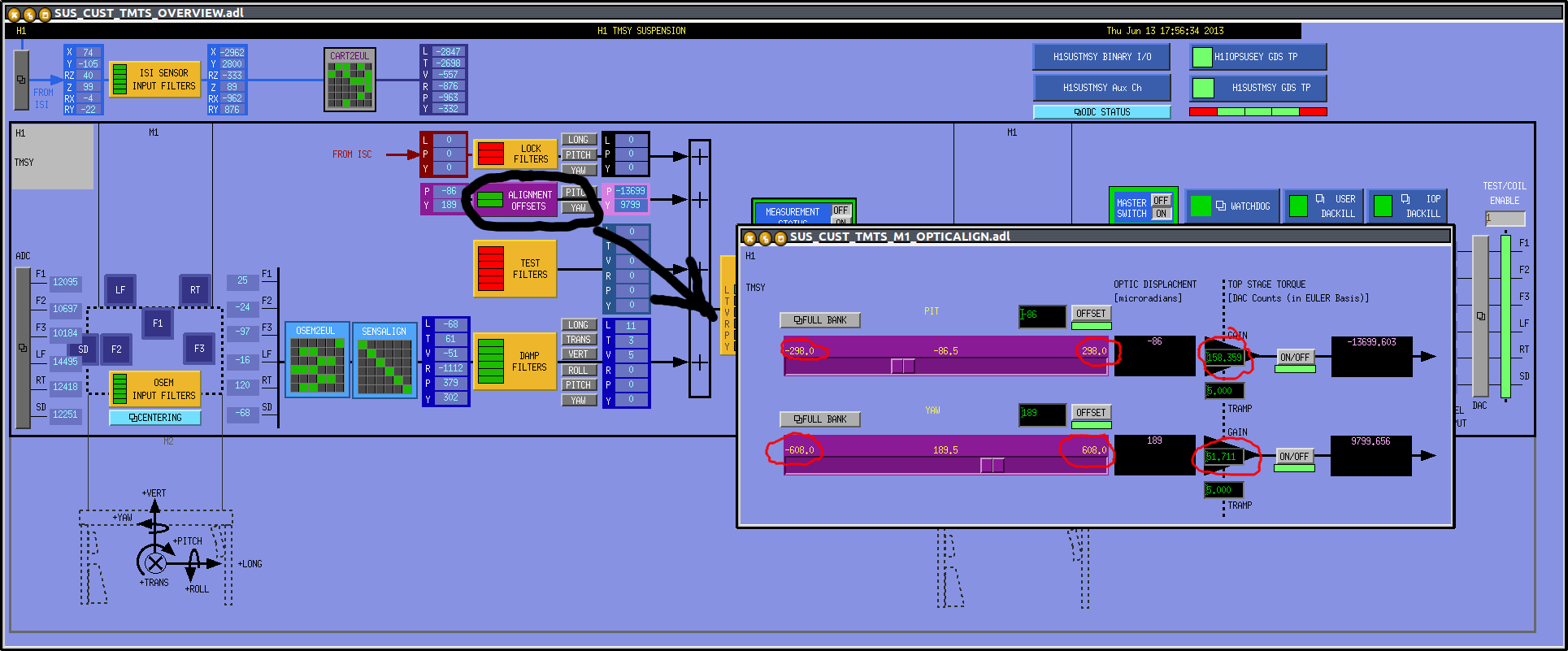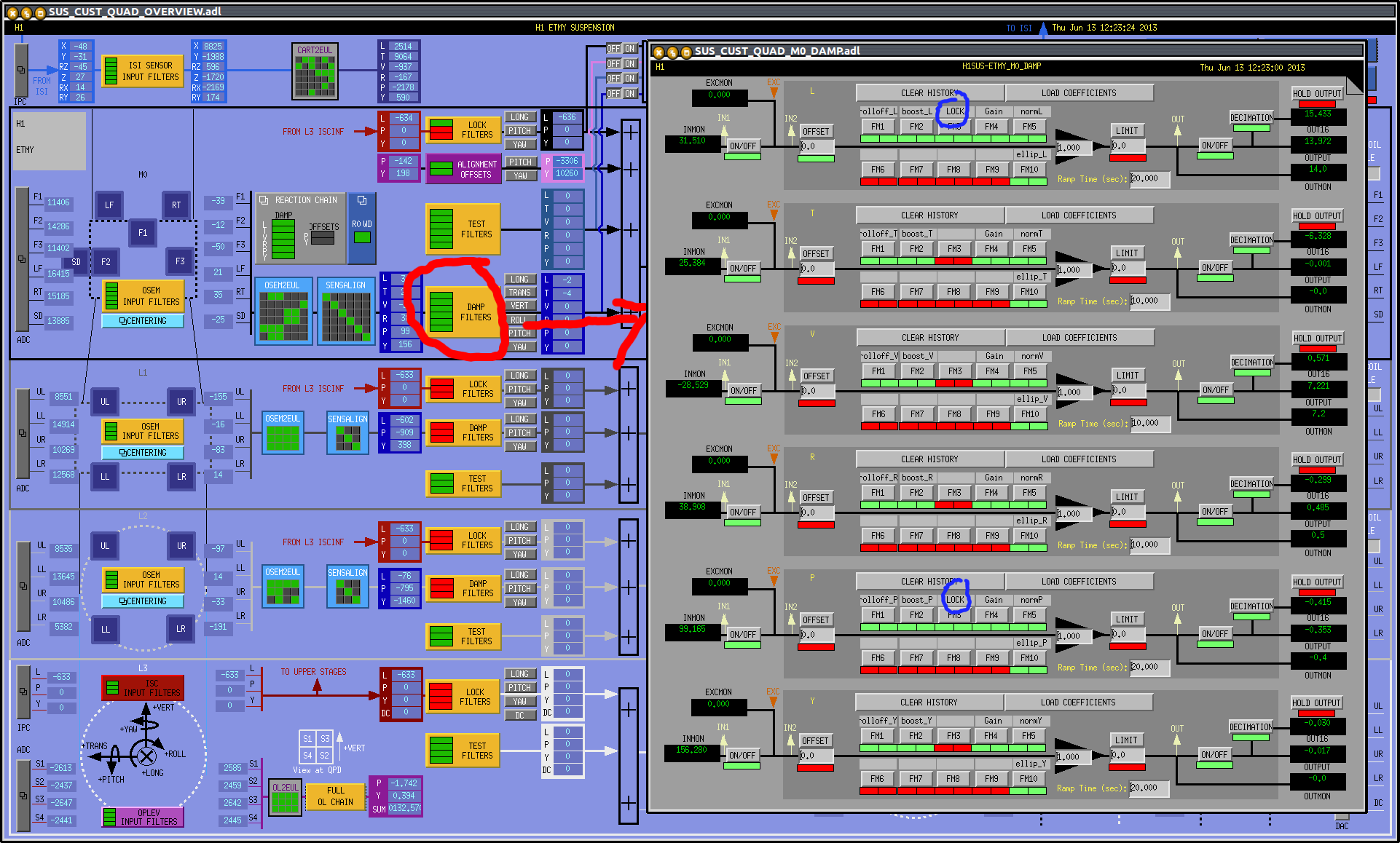Known air leak on GV6 looks to be a "not insignificant" contributor -> Hope to look into this next week
Known air leak on GV6 looks to be a "not insignificant" contributor -> Hope to look into this next week
I installed the feedforward from HEPI L4C to stage 1 of the ISI. The results are really good for a first try. Isolation at the resonance of the chamber around 8Hz is really improved by the feedforward. However, Isolation is deteriorated around 1Hz. With some tuning, it will be reduced.
I have attached the calibrated spectra of stage 2 motion in the X&Y and Z directions measured this morning. The damping, feedback, feedforward and the sensor correction were engaged in the best case.
Models were made for the ISIs of the Output Mode Cleaner yesterday.
I made the related HEPI models today.
Those new models started this morning (both ISI and HEPI). The DAQ was restarted as well to account for the new channels.
The sitemap was updated, and safe.snap files were created.
All files (models, sitemap, macro substitution text files and safe.snap) are commited under the SVN.
This preliminary work will allow checking sensors on OMC ISIs and HEPIs, prior to the actual commissioning start.
Work was performed under WP3974 which is now closed.
For the 35W and 200W laser. 200W laser files end in -001.
The noise around 4 kHz is again present in the 200W laser's RPN plot, and it even shows up in the pointing measurement.
Hugo and Dave.
We started the first version of the HPI and ISI models for HAM4,5,6 this morning. h1boot's rtsystab file was extended. The DAQ master file was reconfigured for the new INI and PAR files. After two restarts due to channel duplication we were done by 11am (started at 10:33). The EPICS gateway did not reconnect to the DAQ cleanly, so I restarted the h1fe-cds gateway.
The DAQ has increased in size by the following
| before | after | |
| num chans | 150,000 | 168,000 |
| frame size (MB for 32 sec frame) | 317 | 348 |
| frame data rate (MBps) | 9.9 | 10.9 |
We have officially exceeded the LDAS 10MByte/sec limit.
Attached are plots of dust counts requested from 5 PM June 12 to 5 PM June 13. Both the dust monitor at location 14 in the LVEA (H2 PSL enclosure) and the dust monitor at location 16 in the LVEA (H1 PSL anteroom) are indicating calibration failures.
[Mark B. Arnaud P.]
In the same manner as the previous changes on BSFM/QUADS, the calibration gain and sliders range of the TMSY have been modified for TMSY

Details :
In order to change the sliders range, the following adl file has been modified : SUS_CUST_TMTS_M1_OPTICALIGN.adl located in /opt/rtcds/userapps/release/sus/common/medm/tmts
It has been commited to the svn and a safe_snap file will be saved when isc team will allow it.
The calculation of the gains and offsets is detailed in TMSY_calibration.m located in /ligo/svncommon/SusSVN/sus/trunkTMTS/Common/MatlabTools and the 2nd picture, from Mark B.'s mathematica model has been used as a reference for M1 to M2 compliance in Pitch and Yaw (rad/N.m)
Mindy J, Greg G, Joe O, Thomas V We have installed the TCS RH at EX onto the suspension cage. Pictures attached. Continuity tested well on all pin out that go up to the suspension cables. We will do another round of testing when the in-air cables are hooked up. Upper RH resistivity ~ 42.5 ohms Lower RH resistivity ~ 41.3 ohms Temp sensor resistivity ~ 101 ohms
(Kiwamu, Jax, Stefan) We entered HAM1 today to get the REFL beam out. In order to maximize the power from the Refl port for the HIFO work, we removed both beam splitters from the path , and adjusted the steering mirror to hit the top of the periscope on ISCT1. (The beams from the splitters were previously just dumped - one of them is designed to be a dump, the other is intended for the in vacuum refl sensors), We also used the opportunity to check that the ther beams (green from arm and red to SHG), were well aligned. Note that with the PRM aligned, the gives us about a Watt in ISCT1, which is currently also in the wrong polarization. We dumped the beam riht after the periscope, but we also layed a beam bump under the periscope - due to the wrong polarization a significant amount of light goes through the bottom periscope mirror. This should allow us to close HAM1 again on Friday.
Transfer functions are running overngight on HAM1-HEPI.
Start time: 8.03pm PCT
Attached are plots of dust counts requested from 5 PM June 11 to 5 PM June 12. Both the dust monitor at location 14 in the LVEA (H2 PSL enclosure) and the dust monitor at location 16 in the LVEA (H1 PSL anteroom) are indicating calibration failures.
Made the simulink models for the ISIs of HAM4, HAM5 and HAM6
Activities for today, the ones that I was notified:
- P-Cal team at X-End station, P-Cal Periscope installation.
- Kiwamu and others, to work in and around HAM01, extract IR IFO refl and POP beams to ISCT1.
- Thomas and Mindy, X-End work, installation of ring heater.
- SUS team and visitors at X-End, welding practice/ETM install.
- Michael R. and Gregorio T. to X-End wrap/bag/tag/remove P-Cal installation hardware.
- Corey G. and Cheryl V. moving TMS items from Y-End to X-end.
- LN2 Delivery to CP1, continues to alarm, level went up above 100, now reading 99.6.
- Small cleanroom found with fans off, see more here.
With lots of work by many over the last few weeks, we are at a point where the TMS Lab is Operational. We still have a few more parts to bring down there, but for the most part, we are getting there. Assembly work (i.e. parts being un-bagged could happen next week) is coming soon and we'll want to transition access to this lab to requiring Full "Bunny" Suit garb (will put a sign up saying so when we are assembling).
We also moved a Dust Monitor from EY to EX (it wasn't on the network and I notified Patrick about this).
There is a visible air gap in the Entry Door to the lab. I've been told we covered this up for EY, so we'll want to probably mimic that soon (because Chris has noticed quite a few bugs in this room during her daily cleaning.
These tables (currently in East Bay/Squeezer Area) were cleaned by Christina/Karen, and are now ready to be occupied (although they are pretty low priority schedule-wise).
ChrisM, MichaelR, GregorioT, RickS This morning, we moved the periscope structure about a foot toward the BSC chamber, lifted it off of the teflon highway strips using the jack screws and support plates, installed the flexures, loaded them using the flexure adjustment screws, and removed the support plates so that the structure was supported by the flexures only. Everything went smoothly. The structure appears to be very rigidly mounted when on the flexures. We were not able to move it, even with some pretty hard bumps. We then lowered it back on to the teflon highway strips using the jack screws and support plates, slid it down the staging location at the BSC end of the A7 Adapter, supported it in the adapter using the upper and lower support plates, removed the stabilizing slides, rotated it 90 deg. to its staging orientation, and installed the rotation stabilizing bars. (See photos). We did all the work today from the BSC side only. We wanted to try this because we won't have access to the other side when the Cryopump/Manifold baffle is in place. It was easy working from the BSC side, so no reason to go to the other side. The A7 Adapter flange protectors arrived just after we finished our inside work. We installed them on the flange (see last photo). We plan to leave the Pcal periscope structure in this location and orientation until the Cryopump/Manifold baffle is installed, then move it into the final location next to the baffle and do the final alignment with the help of IAS.
In order to reduce the motion of the quads at low frequency, I added resonnant gain filters called "LOCK" to the medm filterbank of etmy and itmy. Those filters are designed to help locking the cavity, damping the 0.43Hz and 0.99Hz resonnances of the first longitudinal modes and 0.56Hz of the first pitch mode. The stability of the closed loop hasn't been studied yet, but it looks to be working fine for now. The second and third pictures attached are showing the shape of the damping filters with and without the "LOCK" filter engaged. Those filters are engaged with a ramping time of 10sec.

In Foton :
longitudinal "LOCK" filter = resgain(0.43,2,10)*resgain(1,2,10)
pitch "LOCK" filter = resgain(0.56,2,10)
J. Kissel, A. Pele I've modeled the effect of adding these resonant-gain boost filters on the ETM, and the results are ... interesting. For Pitch, whose design figure of merit is shown in dampingfilters_QUAD_2013-06-14_Level2p1_loopdesign_P.pdf the boost filter only does good. In the 2013-05-01 design, there was plenty of phase margin at low frequency, and the boost was pretty weaksauce. With this boost increase (the previous boost was also at 0.56 Hz), there is still oodles of phase margin on both sides. We shall keep it. For Longitudinal, dampingfilters_QUAD_2013-06-14_Level2p1_loopdesign_L.pdf the situation is a little more dicey. According to the model, with these two new boost filters at 0.43 and 0.56 [Hz], the loop in now only *conditionally* stable, and the phase margin at the last upper unity gain crossing has diminished to 19 [deg]. Assuming that stable locking of the cavity *needs* this level of damping on the lowest two modes, I'll go back the model and look into a redesign that regains unconditional stability and a reasonable phase margin, while continuing to squash these lowest modes. I attach the previous two designs without these boosts for comparison: dampingfilters_QUAD_2013-05-01_loopdesign_L.pdf dampingfilters_QUAD_2013-05-01_loopdesign_P.pdf I've discussed the current implementation with Arnaud, and a couple of other details came up in the discussion. (1) The intent for this additional LOCK filter was that it only be used during lock acquisition, and to be turned off once lock is acquired. As such, the filter has a 10 s ramp on it. It is still yet-to-be tested whether, once lock is acquired, the filter can be turned off, and the QUADs don't ring up again at these frequencies due to ambient excitations. Regardless of this original design intent, I'm going to try and design a filter set than can be left on at all times. I think it's doable. (2) ONLY the ETM has the extra resgain(1,2,10) filter, because when Arnaud tried this on the ITM the loops went unstable. My guess is that this is because the ITM is still a "wirerehang," and so his resonances are different enough that the open loop gain had instabilities. I'll also look into this. Finally, I'll use Vincent's recent 2013-05-14 data as my BSC-ISI ST2 input, instead of Matt's model to assess the overall performance.